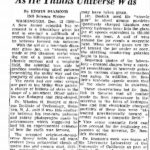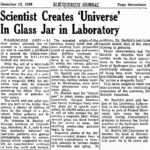Winston H. Bostick newspaper clippings. Note: For peer-reviewed articles on this subject, see Bostick’s bibligraphy and the article on plasmoids.
Scientists Generated Needed Temperature To Tap H-Power (11 Dec 1956)
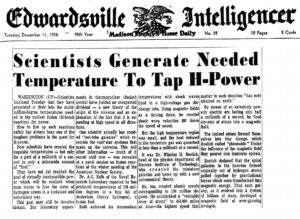
| Scientists Generated Needed Temperature To Tap H-Power |
|
| WASHINGTON (UP) — Scientists disclosed Tuesday that they have generated in their labs the multi-million-degree temperatures needed to tap nuclear fusion (H-bomb reaction) for power.
How to fire up such reactions safely has always been one of the toughest problems in the quest for H-power. Now scientists have created the requisite temperatures — but only for a part of a millionth of a second in only a minuscule amount of “fuel”. They have not yet reached the goal of virtually inexhaustible power which will be realized when man learns to fuse the cores of hydrogen atoms in a sustained and non-violent way. This goal may still be decades distant, but laboratory experiments in thermonuclear (fusion) control have yielded an unexpected dividend — a new theory of the origin of the universe and an explanation of the fact that it is expending at high speed in all directions. One scientist actually has created “test-tube galaxies” which resemble the vast star systems that make up the universe. This and other information — much of it secret until now — was revealed at a panel session on fusion reactions at the winter meeting of the American Nuclear Society. Dr A.C. Xolb of the Naval Research Laboratory reported he has produced temperatures of 100 million degrees in a tiny bit of deuterium (heavy hydrogen), a fusion fuel. Kolb achieved his tremendous |
temperatures with shock waves fired in a high-voltage gas discharge tube. Using magnetic fields as a driving force, he created shock wave velocities 250 times the speed at sound.
But the high temperature region was small, and the heat induced in the deuterium gas was quenched in less than a millionth of a second. It was Dr Winston H. Bostick, head of the physics department of Stevens Institute of Technology, who created the miniature galaxies and came up with a new astronomical theory. He, too, created atomic speeds corresponding to 100 million degrees. He accelerated a “veritable river of atoms” to 450,000 miles an hour — the highest speed that matter in such densities ‘has ever attained on earth.” By means of an extremely powerful electric arc lasting only half a millionth of a second, he fired streams of atoms into a magnetic field. The ionized atoms formed themselves into tiny clumps which Bostick called “plasmoids.” Under the influence of the magnetic field they formed into luminous spirals. Bostick deduced that the spiral galaxies in the heavens formed originally out of hydrogen atoms pulled together by gravitational forces which were transformed into magnetic energy. Thus each galaxy, as it evolved into a system of billions of stars, developed a magnetic field of ever-growing strength. |
From 11 Dec 1956 Edwardsville Intelligencer (Edwardsville, Illinois)
Creation of the Universe Duplicated in a Test Tube (12 Dec 1956)
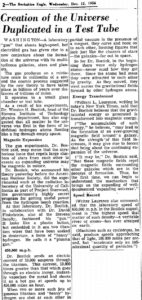
| Creation of the Universe Duplicated in a Test Tube | |
| WASHINGTON — A laboratory “gun” that shoots high-speed hot electrified gas has given rise to a new conjecture about the formation of the universe with its multitudinous galaxies, stars and planets.
The gun produces miniature scale in millionths of a second the cosmic process suggested by the new theory to have taken place in billions of years over distances of trillions of miles. It operates in a small glass chamber or test tube. As a result of his experiments, Dr. Winston H. Bostick, head of the Stevens Institute of Technology physics department, has also suggested that all matter in the universe was first in the form of individual hydrogen atoms floating like a fog through empty space. Magnetic Expansion The gun experiments, Dr. Bostick said, may mean that the mysterious force that repels large clusters of stars from each other to create an expanding universe may be magnetic in nature. Dr. Bostick, who announced his theory yesterday before the American Nuclear Society, did the experimental work at the radiation laboratory of the University of California as part of Project Sherwood, the government’s highly secret program for getting useful power from the hydrogen bomb reaction. At that laboratory, Dr. Bostick, in collaboration with Dr. David Finkelstein, also of the Stevens faculty, fashioned his “gun.” It looks like a plastic button, but embedded in it are two titanium wires that have been soaked in deuterium, a form of “heavy” hydrogen. He calls it a “plasma gun”. 450,000 m.p.h Dr. Bostick sends an electric current of 10,000 amperes through the titanium. This current, 10,000 times greater than that which goes through an electric ironer, instantly vaporizes the metal and shoots it as a hot gas at speeds of to 450,030 miles an hour. When two or more such jets of gaseous titanium and “heavy” hydrogen are shot at each other in |
partial vacuum in the presence of a magnet, they curve and hook on to each other, forming figures that look just like the clusters of stars — the galaxies — far out in space.
So for Dr Bostick, in the beginning there were only hydrogen atoms — never mind how they got there. Since the atoms had mass they were attracted to each other by gravity. As they moved, they went across the gravitational fields formed by other hydrogen atoms. Energy Transformed William L. Laurence, writing in today’s New York Times, said that Dr. Bostick believes that the gravitational energy so generated is transformed into magnetic energy. “The accumulation of such energy,” he believes, “may lead to the formation of an ever-growing magnetic field ‘around a galaxy. As the strength of this field increases, it may give rise to forces that bring about the continuing expansion of the universe. “It may be,” Dr. Bostick said. “that these magnetic fields repel the magnetic fields surrounding other galaxies which are in the process of formation. Thus, for the first time, we can begin to understand the mechanism that brings on the expanding of well-documented ‘expanding universe’.” Speed Record Writer Laurence also commented that the laboratory speed of 450,000 m.p.h. in the Bostick experiment is “the highest speed that matter of such density — a veritable river of atoms — has ever attained on earth. Machines such as cyclotrons, he said, produce speeds approaching that of light, 186,000 miles per second, but “accelerate only an infinitesimal quantity of particles.” |
From 12 Dec 1956 Berkshire Evening Eagle, The (Pittsfield, Berkshire, Massachusetts)
Scientist Re-Creates Jar As He Thinks Universe Was (13 Dec 1956)
Scientist Creates ‘Universe’ in Glass Jar in Laboratory (13 Dec 1956)
| Scientist Re-Creates Jar As He Thinks Universe Was |
|
| By Edwin Diamond INS Science WriterWASHINGTON. Dec. IS (INS) — A New Jersey Scientist has recreated in a laboratory glass jar and in one-half a millionth of a second the billion-year-long process he believes formed our universe.With the aid of a four-inch diameter glass jar, an “atomic gun” made two titanium metal wires the size of a pencil eraser, an electric current and a magnetic field, the scientist was able to produce smoke-ring sized patterns resembling the milky way and the majority of galaxies in outer space.The earth and our solar system are part of the Milky Way galaxy, a cluster of billions of stars in the shape of a pin-wheel. Other galaxies are S-shaped and ring-shaped.Dr Winston H. Bostick of Stevens Institute of Technology, Hoboken, N.J., said it was this similarity between his test-tube patterns and galaxy photographs made by astronomers which suggested he had hit on experimental evidence of how the earth was formed.The accepted origin-of-the-universe theory holds that all stars evolved from primordial clouds of sparse gas and cosmic dust drifting randomly in space. It also holds the universe is an “expanding” one, in which the various galaxies are rushing away from each other at tremendous speeds.Dr Bostick said his experiments described at the current American Nuclear Society meeting in Washington show how these phenomena |
may have taken place.
Dr Bostick used his “atomic gun” to shoot atomic particles (positively charged titanium and heavy hydrogen ions) into the glass jar at speeds equivalent to 450,000 miles an hour. A coil of wire around the jar creates a magnetic field. When several gases are fired towards the jar center at once, the startling smoke-ring galaxies begin to form. Sequence photos of the laboratory-created shapes bear a marked resemblance to heavenly galaxies in various stages of formation and aging. In addition, Dr Bostick’s test-tube speeds match that of the stars moving in galaxies. These observations led Dr Bostick to theorize that all matter made its first appearance in the universe in the form of hydrogen ions and that electrically charged particles of these ions were “attracted gravitationally towards a center across a magnetic field.” This same magnetic field can also account for the continuing expansion of the universe, Dr Bostick theorized. Dr Bostick’s work was begun at the Livermore Laboratory at the University of California as part of Project Sherwood, code name for the Atom Energy Commission’s program to harness the fusion reaction of the hydrogen bomb for peaceful purposes. Dr Bostick left Livermore to become the head of Steven’s department of physics earlier this year. He is forty years old. |
From: 13 Dec 1956. Kingsport News (Kingsport, Tennessee)
From: 13 Dec 1956. Albuquerque Journal (Albuquerque, New Mexico)
Guns Produce Cosmos (15 Dec 1956)
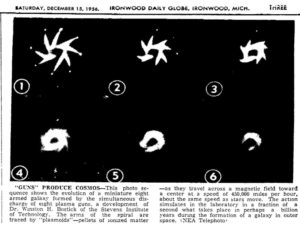
| “GUNS” PRODUCE COSMOS — This photo sequence shows the evolution of a miniature eight armed galaxy formed by the simultaneous discharge of eight plasma guns, a development of Dr. Winston H. Bostick of the Stevens Institute of Technology. The arms of the spiral are traced by “plasmoids” — pellets of ionized matter | — as they travel across a magnetic field towards a center at a speed of 450,000 miles per hour, about the same speed as stars move. The action simulates in the laboratory in a fraction or a second what takes place in perhaps a billion years during the formation of a galaxy in outer space. (NEA., Telephoto) |
15 Dec 1956. Ironwood Daily Globe (Ironwood, Michigan)
Creates Test Tube Universe (20 Dec 1956)
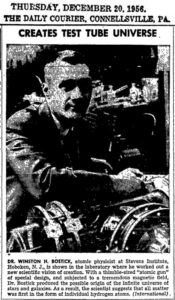
| Dr. WINSTON H. BOSTICK, atomic physicist at Stevens Institute, Hoboken, N.J. is shown the laboratory where he worked out a new scientific vision of creation. With a thimble-sized “atomic gun”, of special design, and subjected to a tremendous magnetic field, Dr. Bostick produced the possible origin of the infinite universe of stars and galaxies. As a result, the scientist suggests that all matter was first in the form of individual hydrogen atoms. (International). |
From: 20 Dec 1956. The Daily Courier (Connellsville, Pennsylvania)
Laboratory Galaxy (24 Dec 1956)
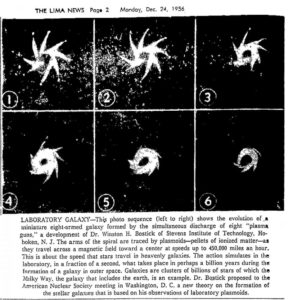
| LABORATORY GALAXY — This photo sequence (left to right) shows the evolution of a miniature eight-armed galaxy formed by the simultaneous discharge of eight “plasma guns,” a development at Dr. Winston H. Bostick of Stevens Institute of Technology, Hoboken, N.J. The arms of the spiral are traced by plasmoids — pellets of ionized matter — as they travel across a magnetic field toward a center, at speeds up to 450,000 miles an hour. This is about the speed that stars travel in heavenly galaxies. The action simulates in the laboratory, in a fraction of a second, what takes place in perhaps a billion years during the formation of a galaxy in outer space. Galaxies are clusters of billions of stars of which the Milky Way, the galaxy that includes the earth, is en example. Dr. Bostick proposed to the American Nuclear Society meeting in Washington, D. C. a new theory on the formation of the stellar galaxies that is based on his observations of laboratory plasmoids. |
From: 24 Dec 1956. Lima News (Lima, Ohio)
2½ Million MPH Motor Described by Scientist (31 Jan 1958)
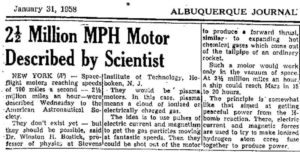
| 2½ Million MPH Motor Described by Scientist
NEW YORK (A) Space-flight motors reaching speeds of 700 miles a second – 2½ million miles an hour — were described Wednesday to the American Astronautical Society. They don’t exist yet — but they should be possible, said Dr. Winston H. Bostick, professor of physics at Stevens |
Institute of Technology, Ho broken N.J.
They would be plasma motors. In this case, plasma means a cloud of ionized or electrically charged gas. The idea is to use pulses of electric current and magnetism to get the gas particles moving at fantastic speeds. Then they could be shot out of the motor |
to produce a forward thrust, similar to expanding hot chemical gases which come out of the tailpipe of an ordinary rocket.
Such a motor would work only in the vacuum of space. At 2½ million miles an hour, a ship could reach Mars in 15 to 20 hours. The principle is somewhat like that aimed at getting peaceful power from the H-bomb reaction. There electric current and magnetic forces are used to try to make ionized hydrogen atom cores fuse together to produce power. |
31 Jan 1958. Albuquerque Journal (Albuquerque, New Mexico)
